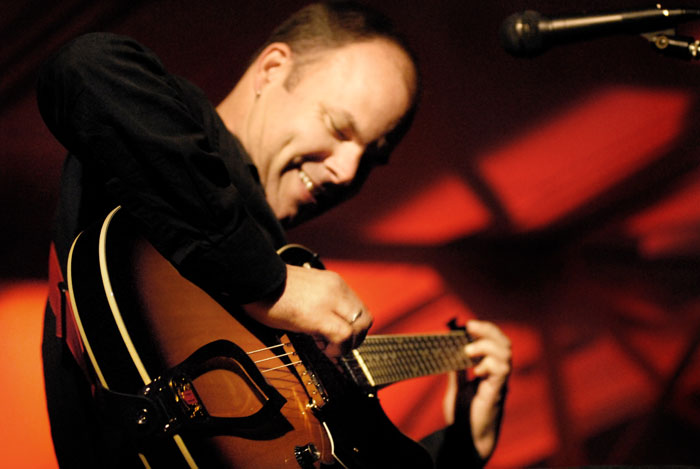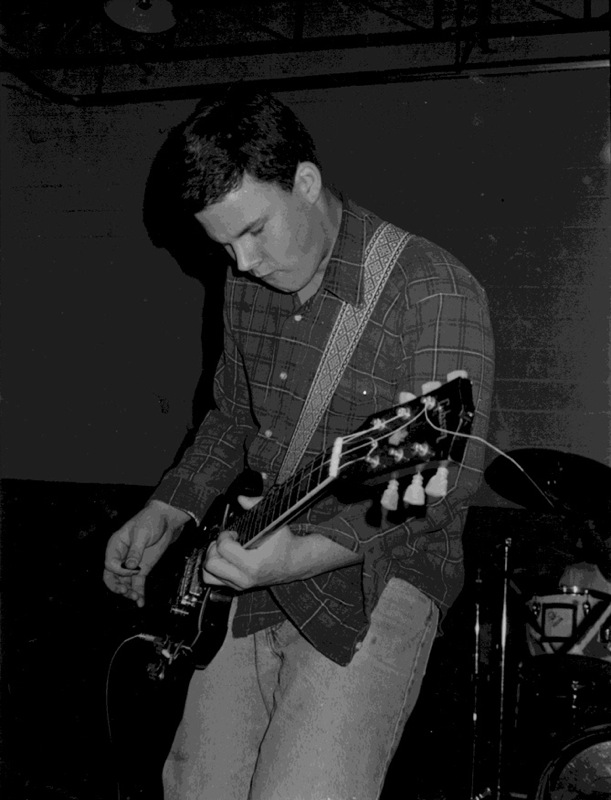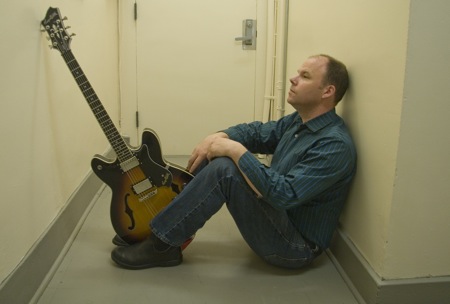With the release of The Plain Where the Palace Stood (out April 16th via Drag City Records), David Grubbs further cements his standing as one of indie rock’s most influential founding fathers. Beginning in the early 80’s with his high school band (and hardcore progenitor) Squirrel Bait Youth, Grubbs started down a road that would lead to collaborations with avant-garde composers and literary artists alike. Drawing on influences from American traditionalists like John Fahey and Sandy Bull to more recent experimental artists like Loren Connors and Mats Gustafsson, Grubbs incorporates these sometimes disparate elements into a cohesive and seamless whole. He recently took some time to answer a few questions for Beats Per Minute concerning his upcoming album The Plain Where the Palace Stood, his experiences in the bands that led up to his most recent work, and how he can’t seem to stop listening to the new Bonnie Prince Billy and Dawn McCarthy album What The Brothers Sang.
Beats Per Minute (Joshua Pickard): I recently heard the songs from the With Illustrations 7” you put out with The Happy Cadavers back in 1982, and as I was listening to them, I couldn’t help but be curious if you ever think back to the earliest days of your career and wonder what might have happened had you made different choices in regards to the course of your music?
David Grubbs: I can’t tell you how strange it is to have someone in 2013 tell me that they recently heard the Happy Cadavers’ EP, which came out in 1982, when I was 14 years old. Absolutely bizarre. The next thing I know, you’ll be telling me that you’re listening to the Squirrelbait Youth demos. As far as making different choices, I’m often creeped out when someone looks back and says that they wouldn’t change a thing. (This morning I was reading about a documentary about Dick Cheney in which he says that he wouldn’t do anything differently if he were to do the Bush years all over again. Terrifying.) That said, I’m having a hard time envisioning having made different choices, and I think that this is because I don’t feel locked in because of choices that I’ve made, and I like to think that with every new record or tour or collaboration I’m free to proceed completely differently. I really don’t feel equal to the sum of my choices.
BPM: You ran with Squirrel Bait (which I believe was originally called Squirrelbait Youth) from ’83 to ’88. And I know that the band underwent several member changes over its tenure but could you tell me a bit about how you, Clark Johnson, and Rich Schuler initially came together to form the band?
DG: Yes, Clark Johnson and I—who have known each other since we were two years old—were teenage wiseasses in Louisville and we thought for a joke we would start a goof hardcore band called Squirrelbait Youth. (This was when there were all kinds of “Youth” bands—Wasted Youth, Reagan Youth, Youth Brigade, Youth of Today, etc.) But as so often happens, what started out purely as a laugh gained unexpected traction and went charging down a path we could not have anticipated.
BPM: Squirrel Bait has been mentioned alongside Husker Du as musical antecedents to the grunge movement that began in the late 80’s and early 90’s. Was there ever a time in your formative years with Squirrel Bait, or The Happy Cadavers for that matter, when you felt that you were doing something new and innovative? Or was it more of just a natural progression for you and the band and not really given much thought?
DG: Squirrel Bait really took off when Peter Searcy joined the band as our singer. I don’t think that we really imagined what we were doing to be innovative, but that’s not to say that we also didn’t imagine it to be unique. People describing Squirrel Bait usually did so by referring to Hüsker Dü and The Replacements, which is altogether fair. But that’s not to say that Squirrel Bait wasn’t without its idiosyncracies—starting with the fact that we were high-school students who sometimes had to be driven by their parents when playing out-of-town shows. (I remember Clark’s mother driving us up to Chicago to play with Big Black.)
BPM: You had passing tenure in quite a few bands, not the least of which was Gastr del Sol, a creative partnership you had with Jim O’Rourke. Were there any differences in execution or changes in approach to the material recorded as Gastr del Sol as opposed to your previous solo/collaborative studio experiences?
DG: The final lineup of Bastro consisted of John McEntire, Bundy K. Brown, and myself, and we made a tires-squealing abrupt stylistic left turn in 1992 and became Gastr del Sol. We got rid of our regular practice space and fixed personnel and even some of our amplifiers. The idea was to be able to play in our living room—to utterly change the scale of the music that Bastro had been playing, to unilaterally disarm ourselves. The first to enter the revolving door of Gastr del Sol personnel was Jim O’Rourke, and his musical and artistic personality was sufficiently strong that Gastr del Sol promptly became the duo of Jim and me with whomever else we invited to join us. I learned an enormous amount from Jim—what an incredibly talented, focused person. For me, it really was a profoundly different way of working, and one that I’ve more or less kept to through to the present day—that sense of ad hoc working relationships and ensembles that are convened for a specific project.
BPM: In ’97 you reissued Squirrel Bait’s vinyl releases on the Drag City sub-label Dexter’s Cigar—an imprint which you had an active role in running. What were the circumstances surrounding your initial involvement with Dexter’s Cigar?
DG: I think that Jim and I were constantly pestering Drag City to reissue certain records that we loved—first the Red Krayola, but then quickly Voice Crack, Merzbow, Derek Bailey, etc.—and Dan Koretzky and Dano Osborn from Drag City had the excellent idea (and the generosity) to give us a crack at directing our own label, and one that they would manufacture and distribute. That’s still my arrangement with Drag City for Blue Chopsticks—and they’re still such extraordinarily generous, game folks.
BPM: Something which I found very interesting was that from roughly 1999-2007, you regularly contributed music criticism to Suddeutsche Zeitung, a Munich newspaper. Did you have a prior professional relationship with someone on staff there or with the newspaper itself? Were your submissions ever written with a thought to who might possibly be reading them in Munich, being that the reader’s might not be familiar with the specific artists and bands you were writing about?
DG: That was an interesting job, no question about it. I did sometimes feel like I was sending these reviews off to be published in a parallel dimension—but then I’d go to Germany to play shows and people would treat me as a musician-critic. Or as a critic-musician. One or the other. My editor was Karl Bruckmaier, who I knew from having played on his radio show right around the time that Gastr del Sol started, and I still do various projects with Karl, including music for his radio plays. I think that I treated the criticism the same way as if I had been writing for a major newspaper in the US; I didn’t presume that anyone was familiar with the artist I was writing about, and I tried to make my arguments broadly accessible. For a long while Karl edited a dynamite page in the Feuilleton section, with regular contributions from Amiri Baraka and Kevin Coyne as well.
BPM: In Augusto Contento’s excellent 2012 documentary Parallax Sounds, you were profiled along with fellow musicians Damon Locks, Ken Vandermark, Ian Williams, and Steve Albini. Can you talk a bit about your participation in the filming of that, including how you came to write two new songs for the soundtrack?
DG: Augusto Contento and the producer Giancarlo Grande contacted me four or five years prior to shooting Parallax Sounds. I contributed music to Augusto’s earlier film Strade Trasparenti (by the way, there’s a very nice soundtrack album to this film on Staubgold with a marvelous track by the Necks), and because I admired his films I was glad to have the opportunity to really dive into Parallax Sounds. I participated in nearly a full week of shooting and was fascinated to see Chicago—where I had lived for ten years, but which I had also left more than a decade earlier—not only through tracing my own footsteps, but also through what was meaningful to an Italian documentary filmmaker.
BPM: Your upcoming record The Plain Where the Palace Stood feels grounded in the American folk and raga traditions of artists like John Fahey and Robbie Basho. Was there ever a time, whether during the recording of this album or sometime in the past, that you felt a kinship (read: obsession) with any particular artist(s)?
DG: I do tend to listen to and think about music in one obsessive phase after another. For the last week I’ve been listening to recordings of shape-note singing and to Dawn McCarthy’s and Will Oldham’s new album of Everly Brothers covers. For the past several months, I’ve immersed myself in Carlo Gesualdo’s seventeenth-century madrigals, particularly the fifth book, which I’ll be playing soon in an ensemble of five guitarists assembled by Noël Akchoté. The Plain Where the Palace Stood was made over a long period of time—two years—so it’s difficult to describe it as reflecting a particular obsession.
BPM: The Plain Where the Palace Stood feels very cinematic, almost score-like at times. Now I know that you’ve done multiple soundtracks for films, radio programs, and art installations, but was there anything different about the writing and recording of this record that set it apart from any of your previous non-collaborative solo albums?
DG: The album owes a lot to the trio with Andrea Belfi and Stefano Pilia that I’ve been playing with for the last several years, and which is just now finishing a second album—and one which feels like it continues forward from The Plain. I feel that I’ve had a really wonderful run of collaborations in the last several years (especially the work with Susan Howe, Anthony McCall, and Angela Bulloch), and these working relationships I’m certain have inspired me to make the solo records a little less “solo.”
BPM: Obviously there will be a tour in support of The Plain Where the Palace Stood. Seeing as how you and your family live in Brooklyn (as well as your having a full-time job as an Associate Professor at the Conservatory of Music at Brooklyn College), do you ever try to limit your touring schedule after each of your releases? Maybe especially for overseas dates, in terms of duration or frequency?
DG: Ah, but I’m on sabbatical this year. What a beautiful word.
BPM: Are there any relatively new artists that you’ve been listening to lately? Maybe an album that you’re particularly anxious to hear that is set to come out this year or maybe was just released?
DG: Again, Dawn and Will’s Everly Brothers record is killing me. I’ve also been listening to the Music for Saharan Cell Phones compilations and trying to keep current with Oren Ambarchi’s great string of recent albums—as well as the ones with Keiji Haino and Jim O’Rourke and with Haino and Stephen O’Malley. Not that any of those albums have much of anything to do with one another: Kentucky, Mali, Melbourne/Tokyo.
BPM: One last thing: Seeing as how you’re absolutely no stranger to creative collaboration is there any current artist—or past artist, for that matter—that you’d really love to work with but with whom you’ve possibly never had the opportunity?
DG: Merce Cunningham—too late. But there’s always (or at least still) The Wooster Group.
David Grubbs’ upcoming record The Plain Where the Palace Stood is due out April 16th on Drag City Records.




